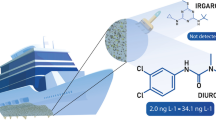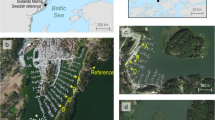Abstract
Risks posed by antifouling agents (irgarol 1051, diuron and dichlofluanid) to the aquatic environment of the Gulf of Napoli have been estimated. Seawater samples were collected monthly in selected harbours and marinas of this area during the boating season (March to November 2005) and off-season (January 2006). Concentration levels have been measured, and the resulting data used to perform a probabilistic ecological risk assessment independently on each biocide. Diuron exhibited higher concentration levels than irgarol 1051 in all the investigated locations: Dissolved concentrations of diuron ranged from <1 to 1,380 ng l−1, whereas dissolved concentrations of irgarol 1051 ranged from <0.2 to 173 ng l−1. Contamination appears to be largely dependent on the type and configuration of sampling sites and on the residence time and the density of boats. High levels of booster biocides were associated with marinas housing several recreational water craft and/or fishing boats, whilst commercial ports usually exhibited low concentrations. A seasonal influence was observed, with peak and lowest values found in early summer months and during winter, respectively. The comparison of the respective toxicity benchmarks, expressed as 10th percentiles, suggests that plant species are more sensitive to irgarol 1051 (297 ng l−1) than diuron (4,846 ng l−1). Based on these conservative effect thresholds for plants, ecological risk from the single investigated biocides can be judged to be low in the study area.




Similar content being viewed by others
References
Basheer, C., Tan, K. S., & Lee, H. K. (2002). Organotin and irgarol 1051 contamination in Singapore coastal waters. Marine Pollution Bulletin, 44, 697–703. doi:10.1016/S0025-326X(01)00330-7.
Bednarz, T. (1981). The effect of pesticides on the growth of green and blue-green algae cultures. Acta Hydrobiologica (Cracow), 23, 155–172.
Biselli, S., Bester, K., Hűhnerfuss, H., & Fent, K. (2000). Concentrations of the antifouling compound irgarol 1051 and of organotins in water and sediments of German North and Baltic Sea Marinas. Marine Pollution Bulletin, 40, 233–243. doi:10.1016/S0025-326X(99)00177-0.
Bowman, J. C., Readman, J. W., & Zhou, J. L. (2003). Seasonal variability in the concentrations of irgarol 1051 in Brighton marina, UK; including the impact of dredging. Marine Pollution Bulletin, 46, 444–451. doi:10.1016/S0025-326X(02)00464-2.
Carbery, K., Owen, R., Frickers, T., Otero, E., & Readman, J. W. (2006). Contamination of Caribbean coastal waters by antifouling herbicide Irgarol 1051. Marine Pollution Bulletin, 52, 635–644. doi:10.1016/j.marpolbul.2005.10.013.
Chesworth, J. C., Donkin, M. E., & Brown, M. T. (2004). The interactive effects of the antifouling herbicides Irgarol 1051 and Diuron on the seagrass Zostera marina (L.). Aquatic Toxicology (Amsterdam, Netherlands), 66, 293–305. doi:10.1016/j.aquatox.2003.10.002.
Cresswell, T., Richards, J. P., Glegg, A. G., & Readman, J. W. (2006). The impact of legislation on the usage and environmental concentrations of irgarol 1051 in UK coastal waters. Marine Pollution Bulletin, 52, 1169–1175. doi:10.1016/j.marpolbul.2006.01.014.
Di Landa, G., Ansanelli, G., Ciccoli, R., & Cremisini, C. (2006). Occurence of antifouling paint booster biocides in selected harbors and marinas inside the Gulf of Napoli: A preliminary survey. Marine Pollution Bulletin, 52, 1541–1546. doi:10.1016/j.marpolbul.2006.05.027.
Fernandez-Alba, A. R., Hernando, M. D., Piedra, L., & Chisti, Y. (2002). Toxicity evaluation of single and mixed antifouling biocides measured with acute toxicity bioassays. Analytica Chimica Acta, 456, 303–312. doi:10.1016/S0003-2670(02)00037-5.
Gatidou, G., Thomaidis, N. S., & Zhou, J. L. (2007). Fate of Irgarol 1051, diuron and their main metabolites in two UK marine systems after restrictions in antifoulig paints. Environment International, 33, 70–77. doi:10.1016/j.envint.2006.07.002.
Giacomazzi, S., & Cochet, N. (2004). Environmental impact of diuron transformation: a review. Chemosphere, 56, 1021–1032. doi:10.1016/j.chemosphere.2004.04.061.
Haglund, K., Bjbrklund, M., Gunnare, S., Sandberg, A., Olander, U., & Pedersen, M. (1996). New method for toxicity assessment in marine and brackish environments using the macroalga Gracilaria tenuistipitata (Gracilariales, Rhodophyta). Hydrobiologia, 326/327, 317–325. doi:10.1007/BF00047825.
Hall Jr, L. W., & Gardinali, P. R. (2004). Ecological risk assessment for Irgarol 1051 and its major metabolite in United States Surface Waters. Human and Ecological Risk Assessment, 10, 525–542. doi:10.1080/10807030490452188.
Hall Jr, L. W., Giddings, J. M., Solomon, K. R., & Balcomb, R. (1999). An Ecological risk assessment for the use of Irgarol 1051 as an algaecide for antifoulant paints. Critical Reviews in Toxicology, 29, 367–437.
Hall Jr, L. W., Killen, W. D., Anderson, R. D., Gardinali, P. R., & Balcomb, R. (2005). Monitoring of Irgarol 1051 concentrations with concurrent phytoplankton evaluations in East Cost areas of the United States. Marine Pollution Bulletin, 50, 668–681. doi:10.1016/j.marpolbul.2005.02.025.
Harino, H., Mori, Y., Yamaguchi, Y., Shibata, K., & Senda, T. (2005). Monitoring of antifouling booster biocides in water and sediment from the Port of Osaka, Japan. Archives of Environmental Contamination and Toxicology, 48, 303–310. doi:10.1007/s00244-004-0084-2.
Holt, J. S., Powles, S. B., & Holtum, J. A. M. (1993). Mechanisms and agronomic aspects of herbicide resistance. Annual Review of Plant Physiology and Plant Molecular Biology, 44, 203–229. doi:10.1146/annurev.pp.44.060193.001223.
Hollister, T., & Walsh, G. E. (1973). Differential responses of marine phytoplankton to herbicides: oxygen evolution. Bulletin of Environmental Contamination and Toxicology, 9, 291–295. doi:10.1007/BF01684786.
Huang, X. J., Pedersen, T., Fischer, M., White, R., & Young, T. M. (2004). Herbicide runoff along highways. 1. Field observations. Environmental Science & Technology, 38, 3263–3271. doi:10.1021/es034847h.
IMO (2001). International convention on the control of harmful anti-fouling systems on ships. London: International Maritime Organization.
Konstantinou, I. K., & Albanis, T. A. (2004). Worldwide occurrence and effects of antifouling paint booster biocides in the aquatic environment: a review. Environment International, 30, 235–248. doi:10.1016/S0160-4120(03)00176-4.
Koutsaftis, A., & Aoyama, I. (2006). The Interactive effects of binary mixtures of three antifouling biocides and three heavy metals against the marine algae Chaetoceros gracilis. Environmental Toxicology, 21, 432–439. doi:10.1002/tox.20202.
Lamoree, M. H., Swart, C. P., van der Horst, A., & van Hattum, B. (2002). Determination of diuron and the antifouling paint biocide irgarol 1051 in Dutch marinas and coastal waters. Journal of Chromatography. A, 970, 183–190. doi:10.1016/S0021-9673(02)00878-6.
Liu, D., Pacepavicius, G. J., Maguire, R. J., Lau, Y. L., Okamura, H., & Ayoama, I. (1999). Survey for the occurrence of the new antifouling compound irgarol 1051 in the aquatic environment. Water Research, 33, 2833–2843. doi:10.1016/S0043-1354(98)00501-6.
Manzo, S., De Luca Picione, F., Di Landa, G., Avagliano, S., Ansanelli, G., Parrella, L., et al. (2006). Ecotoxicological evaluation of contamination by new antifouling compounds in harbour seawater. SETAC Europe 16th Annual Meeting. The Netherlands: The Hague.
Martinez, K., Ferrer, I., Hernando, M. D., Fernandez-Alba, A. R., Marce, R. M., Borrull, F., et al. (2001). Occurrence of antifouling biocides in the Spanish Mediterranean marine environment. Environmental Technology, 22, 543–552. doi:10.1080/09593332208618258.
McFeters, A. G., Bond, P. J., Olson, S. B., & Tchan, Y. T. (1983). A comparison of microbial bioassays for the detection of aquatic toxicants. Water Research, 17, 1757–1762. doi:10.1016/0043-1354(83)90197-5.
Moreland, D. E. (1980). Mechanisms of action of herbicides. Annual Review of Plant Physiology, 31, 597–638. doi:10.1146/annurev.pp.31.060180.003121.
Naessens, M., Leclerc, J. C., & Tran-Minh, C. (2000). Fiber optic biosensor using Chlorella vulgaris for determination of toxic compounds. Ecotoxicology and Environmental Safety, 46, 181–185. doi:10.1006/eesa.1999.1904.
Okamura, H., Aoyama, I., Liu, D., Maguire, J., Pacepavicius, G. J., & Lau, Y. L. (1999). Photodegradation of Irgarol 1051 in water. Journal of Environmental Science and Health. Part. B, Pesticides, Food Contaminants, and Agricultural Wastes, 34, 225–238.
Okamura, H., Aoyama, I., Liu, D., Maguire, R. J., Pacepavicius, G. J., & Lau, Y. L. (2000). Fate and ecotoxcity of the new antifouling compound Irgarol 1051 in the aquatic environment. Water Research, 34, 3523–3530. doi:10.1016/S0043-1354(00)00095-6.
Okamura, H., Ayoama, I., Ono, Y., & Nishida, T. (2003). Antifouling herbicides in the coastal waters of western Japan. Marine Pollution Bulletin, 47, 59–67. doi:10.1016/S0025-326X(02)00418-6.
Okamura, H., Watanabe, T., Aoyama, I., & Hasobe, M. (2002). Toxicity evaluation of new antifouling compounds using suspension-cultured fish cells. Chemosphere, 46, 945–951. doi:10.1016/S0045-6535(01)00204-1.
Omae, I. (2003). Organotin antifouling paints and their alternatives. Applied Organometallic Chemistry, 17, 81–105. doi:10.1002/aoc.396.
Overnell, J. (1975). The effect of some heavy metal ions on photosynthesis in a freshwater alga. Pesticide Biochemistry and Physiology, 5, 19–26. doi:10.1016/0048-3575(75)90039-5.
PAN. (2006). Pesticide Database. Retrieved December 2006 from http://www.pesticideinfo.org/Index.html.
Regan, H. M., Akcakaya, H. R., Ferson, S., Root, K. V., Carroll, S., & Ginzburg, L. R. (2003). Treatments of uncertainty and variability in ecological risk assessment of single-species populations. Human and Ecological Risk Assessment, 9, 889–906. doi:10.1080/713610015.
Sakkas, V. A., Konstantinou, I. K., & Albanis, T. A. (2001). Photodegradation study of the antifouling booster biocide dichlofluanid in aqueous media by gas chromatographic techniques. Journal of Chromatography. A, 930, 135–144. doi:10.1016/S0021-9673(01)01193-1.
Sakkas, V. A., Konstantinou, I. K., Lambropoulou, D. A., & Albanis, T. A. (2002). Survey for the occurrence of antifouling paint booster biocides in the aquatic environment of Greece. Environmental Science and Pollution Research, 9, 327–332.
Sargent, C. J., Bowman, J. C., & Zhou, J. L. (2000). Levels of antifoulant irgarol 1051 in the Conwy marina, North Wales. Chemosphere, 41, 1755–1760. doi:10.1016/S0045-6535(00)00051-5.
Scarlett, A., Donkin, M. E., Fileman, T. W., & Donkin, P. (1997). Occurrence of the marine antifouling agent Irgarol 1051 within the Plymouth Sound Locality: implications for the green macroalga Enteromorpha intestinalis. Marine Pollution Bulletin, 34, 645–651. doi:10.1016/S0025-326X(96)00187-7.
Scarlett, A., Donkin, P., Fileman, T. W., Evans, S. V., & Donkin, M. E. (1999). Risk posed by the antifouling agent Irgarol 1051 to the seagrass, Zostera marina. Aquatic Toxicology (Amsterdam, Netherlands), 45, 159–170. doi:10.1016/S0166-445X(98)00098-8.
Schafer, H., Hettler, H., Fritsche, U., Pitzen, G., Roderer, G., & Wenzel, A. (1994). Biotests using unicellular algae and ciliates for predicting long-term effects of toxicants. Ecotoxicology and Environmental Safety, 27, 64–81. doi:10.1006/eesa.1994.1007.
Solomon, K. R., Baker, D. B., Richards, R. P., & Dixon, K. R. (1996). Ecological risk assessment of atrazine in North American surface waters. Environmental Toxicology and Chemistry, 15, 31–76. doi:10.1897/1551-5028(1996)015<0031:ERAOAI>2.3.CO;2.
Thomas, K. V., Fileman, T. W., Readman, J. W., & Waldock, M. J. (2001). Antifouling paint booster biocides in the UK costal environment and potential risks of biological effects. Marine Pollution Bulletin, 42, 677–688. doi:10.1016/S0025-326X(00)00216-2.
Thomas, K. V., McHugh, M., Hilton, M., & Waldock, M. (2003). Increased persistence of antifouling paint biocides when associated with paint particles. Environmental Pollution, 123, 153–161. doi:10.1016/S0269-7491(02)00343-3.
Thomas, K. V., McHugh, M., & Waldock, M. (2002). Antifouling paint booster biocides in UK coastal waters: Inputs, occurrence and environmental fate. The Science of the Total Environment, 293, 117–127. doi:10.1016/S0048-9697(01)01153-6.
Teisseire, H., Couderchet, M., & Vernet, G. (1999). Phytotoxicity of diuron alone and in combination with copper or folpet on duckweed (Lemna minor). Environmental Pollution, 106, 39–45. doi:10.1016/S0269-7491(99)00066-4.
US EPA. (1998). Guidelines for ecological risk assessment. EPA/630/R-95/002F, Washington DC.
Van Wezel, A. P., & van Vlaardingen, P. (2004). Environmental risk limits for antifouling substances. Aquatic Toxicology (Amsterdam, Netherlands), 66, 427–444. doi:10.1016/j.aquatox.2003.11.003.
Vedrine, C., Leclerc, J. C., Durrieu, C., & Tran-Minh, C. (2003). Optical whole-cell biosensor using Chlorella vulgaris designed for monitoring herbicides. Biosensors & Bioelectronics, 18, 457–463. doi:10.1016/S0956-5663(02)00157-4.
Voulvoulis, N., Scrimshaw, M. D., & Lester, J. N. (1999). Analytical methods for the determination of 9 antifouling paint boosterbiocides in estuarinewater samples. Chemosphere, 38, 3503–3516. doi:10.1016/S0045-6535(98)00580-3.
Voulvoulis, N., Scrimshaw, M. D., & Lester, J. N. (2000). Occurrence of four biocides utilized in antifouling paints, as alternatives to organotin compounds, in waters and sediments of a commercial estuary in the UK. Marine Pollution Bulletin, 40, 938–946. doi:10.1016/S0025-326X(00)00034-5.
Yoshida, T., Maruyama, T., Kojima, H. I., Allahpichay, I., & Mori, S. (1986). Evaluation of the effect of chemicals on aquatic ecosystem by observing the photosynthetic activity of a macrophyte, Porphyra yezoensis. Aquatic Toxicology (Amsterdam, Netherlands), 9, 207–214. doi:10.1016/0166-445X(86)90009-3.
Acknowledgment
The staff of Italian Coast Guard is gratefully acknowledged for the great assistance in field sampling. Moreover, the contribution of Dr. Valeria Ferrara for the map of sampling locations is greatly appreciated.
Author information
Authors and Affiliations
Corresponding author
Rights and permissions
About this article
Cite this article
Di Landa, G., Parrella, L., Avagliano, S. et al. Assessment of the Potential Ecological Risks Posed by Antifouling Booster Biocides to the Marine Ecosystem of the Gulf of Napoli (Italy). Water Air Soil Pollut 200, 305–321 (2009). https://doi.org/10.1007/s11270-008-9914-6
Received:
Accepted:
Published:
Issue Date:
DOI: https://doi.org/10.1007/s11270-008-9914-6




